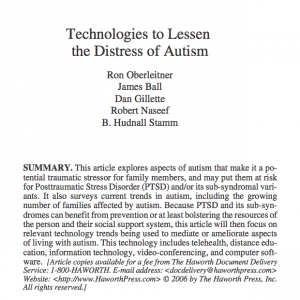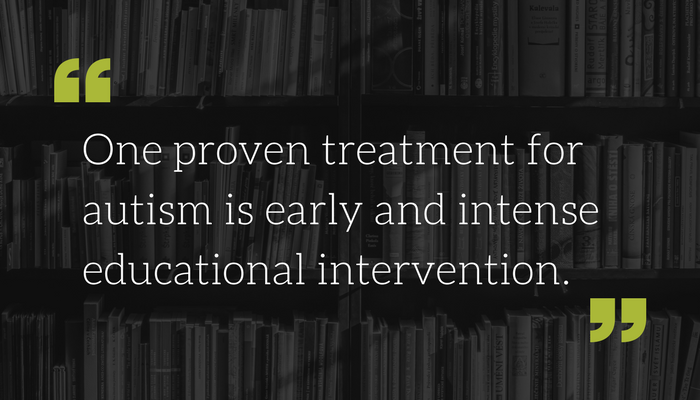Technologies to Lessen the Distress of Autism

By Ron Oberleitner, CEO – Behavior Imaging
This blog shares a title with a paper my colleagues and I wrote and published in Journal of Aggression, Maltreatment & Trauma Vol. 12, No. 1/2, 2006. In it, we explored aspects of autism that make it a potential traumatic stressor for family members and may put them at risk for Posttraumatic Stress Disorder (PTSD). It has been 11 years since our paper was published (actually, the paper was written in 2004), and trauma and distress from autism is still prevalent, although aspects of what is considered autism today is proving to be more varied. In this post, I would like to summarize that paper and update some of its findings to 2017.
Increased Autism Incidence
The last few decades have seen an explosion in the frequency of autism-related disorders. In the 1970s, the incidence was estimated at 1 in 5,000 births (Gerlai, 2004). In 2000, the number was up to 1 in 149 births (Centers for Disease Control and Prevention, 2000). Most recently, on March 27, 2014, the Centers for Disease Control and Prevention (CDC) released new data on the prevalence of autism in the United States. This surveillance study identified 1 in 68 children (1 in 42 boys and 1 in 189 girls) as having autism spectrum disorder (ASD).
Lack of Resources
While the incidence of autism has risen precipitously in the last decade, one thing hasn’t changed much. It is still enormously expensive to provide ongoing education and therapy for autistic children. One proven treatment for autism is early and intense educational intervention. However, for many parents, that intervention is cost and/or distance prohibitive. In some areas, there are few or no options for after-school care or babysitting.
Families at Risk
The increased incidence of autism paired with an ongoing dearth of professional resources means that families often wait for weeks or months for an appointment and must travel to the nearest major medical center for care, sometimes over great distances. As they wait for meaningful care and instruction, the family faces a host of risks.
In the paper, we said:
The constant vigilance to protect one’s child, one’s family, and one’s partner as well as one’s self can leave parents irritable and on edge indefinitely. These symptoms may cause clinically significant problems in daily social and occupational functioning, both from the perspective of PTSD and other physical and mental/behavioral health perspectives.
How autism puts the family at risk:
- Chronic depletion of resources
- Preexisting vulnerabilities may rekindle
- Hyperactivity/lack of sleep
- Feelings of loss
- Harmful and/or unpredictable behaviors
- Environment of captivity/isolation
- Risk for family violence
- Lack of understanding by the general public
- Risk of marital conflict or divorce
Families need more frequent, convenient, and affordable access to autism care professionals to minimize the risk of trauma. For most of my career, I have focused on meeting that need with technology.
Technology to Address Distress
As a starting point around 13 years ago, we looked at the emerging technology categories impacting medical care and special education that were trending in 2004. Technology categories such as telehealth (aka telemedicine), teletherapy, electronic health records, online communication platforms, computer instruction software, and augmentative communication devices, and distance learning were all in relative emerging stages. Several of these have since become ubiquitous, and some are just hitting now as a sensible use of technology to increase access to care.
Telehealth and Autism
In the paper, we defined telehealth as “the use of electronic information and telecommunications technologies to support long-distance clinical health care.” Today, the potential for telehealth to become the standard of care is greater than ever. Everyone carries powerful technology that can be a vehicle for healthcare – a smart phone. Powered by smart phones, telehealth can help individuals with autism around the globe get diagnosed faster and have access to more affordable ongoing treatment. (In the case of Behavior Imaging, we have shown that it can be 40 percent cheaper and 100 percent faster.) Since this paper, millions of dollars have now gone towards researching value of Telehealth. Conditions are right for this type of behavioral healthcare to take over.
Smartphone cameras can capture autistic behaviors as they happen. Autism experts can review footage remotely and provide recommended interventions. Parents and caregivers can review video lectures or take online courses to improve their care. Families that are isolated in rural areas could plug into a host of resources via our current proliferation of information technology. As we said in the initial paper, “Information technology can increase communication, speed research, and coalesce different groups’ efforts to support families and advocate for changes in the caliber of care and services.” The time has come to harness this incredible potential for autism care.
An Exciting New Direction for Autism Diagnosis and Treatment
Telehealth is not a magic wand that will make autism go away, but it can provide resources that help reduce distress in the lives of people with autism and their families. It is an exciting new direction for the medical industry that could usher in a new era of more frequent, convenient, and affordable care. New and now readily accessible technology categories that did not exist in 2006 (examples like cloud computing, virtual reality, intelligent robots, use of big data, and AI or deep learning) are now readily available and will only accelerate the ability for families, and their loved ones with autism, to get the healthcare access they need, regardless of how severe their disability or where they live.
To me, the most exciting times are ahead.






